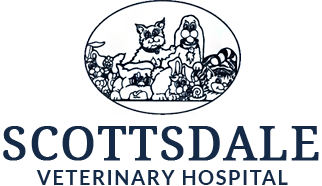Dental and periodontal diseases are seen commonly in our canine and feline friends. Studies have shown that at least 85 percent of dogs and cats have some degree of periodontal disease by three years of age. Oral health is an important part of keeping our pets healthy, and as such an oral visual exam is always a component of our annual wellness examinations here at Scottsdale Veterinary Hospital.
Undetected dental disease or disease left unchecked can lead to health problems involving the heart, kidneys or liver. As periodontal disease worsens, bone loss and tooth root abscesses are common sequelae. This can result in bacterial spread through the body. At greater risk are our senior pets as they more often have other underlying disease processes, such as endocardiosis, renal insufficiency or a mild hepatopathy.
Early recognition and intervention of dental disease is key. Gingivitis and periodontal disease results from subgingival (below the gum line) plaque and tartar accumulation, and bacterial inflammation. If subgingival pocket formation is severe enough, or if there is bone loss or an abscess, tooth extraction is often required. Fractured teeth provide a route for bacterial exposure to underlying support tissues that once infected, can result in further oral disease and subsequent bone loss affecting other teeth.
Anesthetic is a requirement for a complete oral health examination and dental prophylaxis. In reality, there is no possible way a thorough job can be done without anesthetics. Proponents of nonanesthetic dentistry exploit unfounded fears regarding anesthesia and market it as an alternative to veterinary dentistry. As a result, oral health problems can worsen to a point where multiple teeth extractions are needed to prevent serious health complications.
Dental procedures on nonanesthetized patients come with increased risk. Sharp dental instruments lacerating vital ginigival tissues if the patient moves, jaw fractures or neck injuries following restraint, and the potential for aspiration have all been documented.
In an awake state the teeth can only partially be cleaned. Subgingival cleaning and probing cannot occur in an awake animal, no matter how well behaved. Combined with the lack of polishing following scaling of teeth, surfaces are left roughened resulting in much faster disease recurrence. The clean crowns we see after such a cleaning provides us with a false sense of good oral health in our pets.
General anesthesia in contrast is a very safe procedure. Here at Scottsdale Veterinary Hospital we utilize a multimodal approach to anesthetics and pain management. Our registered technicians monitor all patients thoroughly, measuring parameters such as blood pressure, temperature, heart and respiratory rates. We are also capable of monitoring ECG readings and sPO2 (blood oxygenation) values.
A tooth-by-tooth oral examination is critical for a proper dental cleaning. As are radiographs of any teeth that are a concern for bone loss or that have severe pocket formation. Intervention early on saves teeth and improves the quality of life and well-being of our family friends.
If you have any questions or would like to schedule an oral health examination please call one of our informed staff at your convenience.
Resources:
American Veterinary Dental College – Position Statement
(http://avdc.org/Dental_Scaling_Without_Anesthesia.pdf)
Veterinary Partner – Periodontal Disease
(www.veterinarypartner.com/Content.plx?P=A&A=163&EVetID=3004366)
